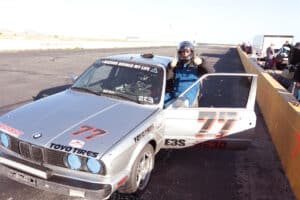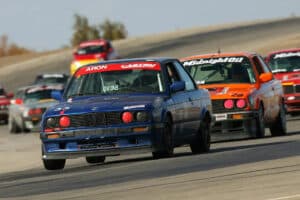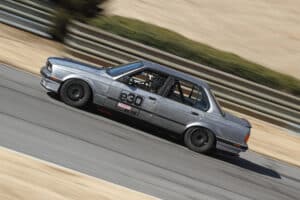
Everything You Wanted to Know About NASA's Spec E30 Racing Series
You would be hard-pressed to find a better example of spec-series racing than Spec E30. This series is consistently one of the largest at NASA Championships events and it has a loyal and dedicated following of racers who just love Spec E30. The series enjoys a broad knowledge base, so any mechanical problems you might encounter are well known and solved without too much trouble. The cars are robust and reliable, affordable and widely available, and the racing is as competitive as you will find in any NASA series.
The Spec E30 Series is a competitive, fun, safe, affordable racing series, focused on road racing with limited modifications and specified required components. The series showcases the driver’s skills and the specified required components manufacturers, distributors, and dealers. Only modifications specifically authorized are allowed, and competitive adjustments are not allowed. Other than the modifications specifically allowed in these rules, every part of the car must remain as it came from the factory.
Only 1984-1991 BMW manufactured non-M E30 chassis automobiles, as made available by BMW in the United States through its authorized dealer network are eligible, with the following restrictions listed in rule 7.3.2. Vehicles with automatic transmissions or four-wheel drive are not eligible. Eligible vehicles include E30 cars originally built as a 318i, 318is, 325, 325E, 325i or 325C provided they contain the Spec E30 eligible drive train from a car originally built as a 325i or 325is.
Taking into account the allowable 0.020 overbore and balancing, the maximum allowable horsepower value for the class is set at 160.9 horsepower and 160.9 pound-feet of torque. An engine that deviates from the 6,300 rpm rev limiter shall be deemed illegal.
Permitted fuel is unleaded pump gasoline, with a maximum octane of 93. Fuel must be from a mass-marketed supplier, e.g. BP, Sunoco, Exxon, or other independent mass marketer, e.g. track supplier or local independent gas station. Fuel additives, other than those supplied in the fuels listed above, are prohibited.” Dyno testing has shown that using a lower octane rated fuel actually makes more power in these low-compression engines, saving even more money at the track!
Average cost to run a weekend — $1,000, but it can be done for less.
Brakes, brands and prices
Check the NASA Contingencies page for the latest programs.
Spec E30 Resources
Questions and Answers to Feed Your Curiosity
No, not in all regions. You will need to contact your local region to find out, or you can search through the NASA Tim and Scoring website to see of any Spec E30s show up where you will be racing.
Latest Spec E30 News Around The Country
Whether you have a street car you run in HPDE, a fire-breathing TTU monster, or one of NASA’s many spec-class racecars, you need quality lubricants […]
Wouldn’t it be great if there were a NASA contingency and Member Benefits partner that offered rewards and discounts on hardcore racing parts we […]
The competition at Chuckwalla Raceway was intense over the Feb. 17-18 weekend as drivers in the Spec E30 class pushed their BMW’s to their limits. […]
Part of what makes the NASA Championships so challenging is the format of qualifying leading to a qualifying race on Saturday, and then the […]
As NASA’s official tire retailer, TrackDayTire.com gives NASA members immediate access to an extensive national inventory of Toyo and Hoosier DOT R […]
What Spec E30 Competitors Say



Get On-Board with Spec E30 Drivers
Spec E30 Series Contacts